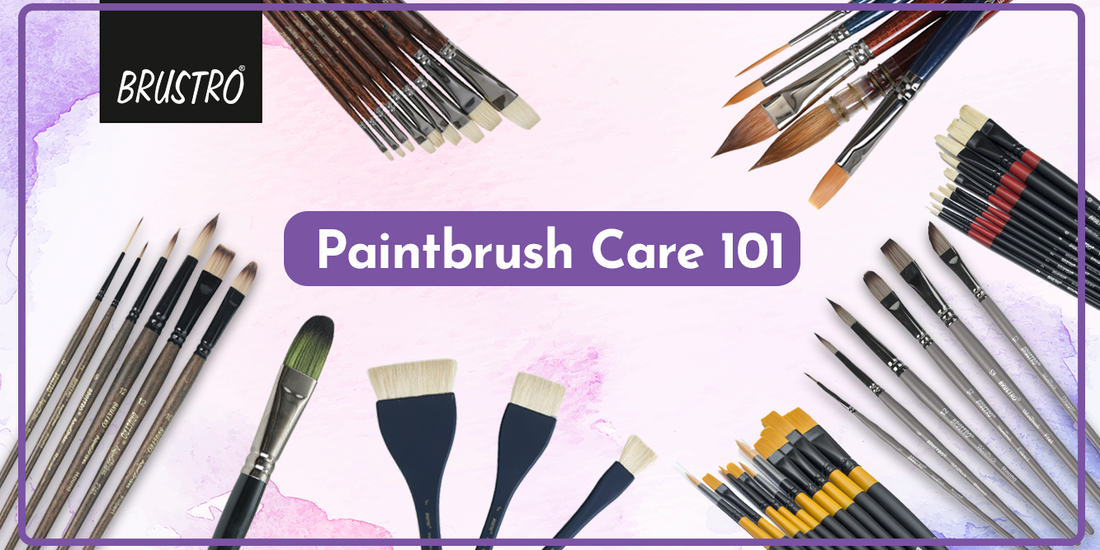Your brushes are your creative companions who help you transform your imagination into stunning art. To keep them performing their best, they need proper care. Before we delve into the details of brush care, let's get to know the fundamental components of a paintbrush.

Paintbrushes 101: Paintbrushes come in two main types: synthetic and natural. Synthetic brushes are known for their durability and are a more budget-friendly option. On the other hand, natural brushes are made from materials like hog or sable hair and are prized for their quality but can be expensive and require more meticulous care. Brustro offers an irresistible range of both Synthetic and Natural brushes designed especially to inspire your artistic needs with precision and creativity.
Before we dive into the details of brush care, let's get to know the basic components of a paintbrush. Picture a paintbrush like a finely crafted tool, consisting of three essential parts. The bristles, located at the end, are the heart of your brush. They come in various shapes and materials each suited to different painting techniques. The ferrule is a metal band that securely holds the bristles and prevents paint from seeping into the handle. Finally, the handle provides you with control and comfort as you apply your creative strokes. These parts work in harmony to bring your artistic vision to life.
Now that you're familiar with the fundamental components of a paintbrush, let's delve right into the essential tips that will help you maintain your brushes in excellent condition and enhance your artistic experience. From selecting the right medium to rejuvenating older brushes, we've got everything you need to know. So, without any further delay, let's get started!

Right Medium is the foundation of Brush Care:
Let's start with selecting the right medium. Different art mediums require specific brushes and care methods. If you prefer acrylic paints, opt for synthetic brushes for their durability. For oil paints, go for natural bristle brushes like hog or sable hair, but be sure to clean them thoroughly with solvents like turpentine. Watercolour enthusiasts should choose delicate brushes like sable, hog or synthetics, rinsing them gently after each use to prevent dried paint buildup. Now, there are versatile brushes available that can be used with more than one medium. However, we recommend having separate brushes for different mediums to ensure the longevity of the brushes.

Brush Care Don'ts:
Now, let's discuss what to avoid to extend your brushes' lifespan. First, never leave your brushes soaking in water, as this can weaken and deform the bristles. Always remember to remove them from water when not in use. Avoid using excessive force when painting, as it can fray and damage the brush tips. Perhaps the most common mistake is neglecting cleaning. Leaving paint to dry on your brushes is a big no-no. It's much easier to clean them immediately after use. Make it a habit to clean them right after each use and they will thank you.

Cleaning Your Brushes - A Soothing Ritual:
Cleaning your brushes after each use is a soothing ritual for both you and your brushes. Here's how to do it right. Start by giving your brushes a thorough rinse in lukewarm water using gentle strokes to remove excess paint. Then, dip them into a mild soap or Brustro Brush Cleanser gently lathering it up and working it through the bristles. Rinse again until the water runs clear. Be patient; rushing this step may leave behind residue. If you are using oil paint you can opt for turpentine oil or Brustro Professional Odour-Free Mineral Spirits, specifically designed for oil paint. Once you are done washing the bristles. Finally, reshape the bristles to their original form and lay them flat on a clean towel to air dry. Never leave them upright, as water can seep into the ferrule and damage it.
Where Brushes Should Rest and Recuperate?:
To keep your brushes in optimal condition, store them vertically in a dedicated brush container or protect them by wrapping them in a clean cotton cloth. For those with unique brush storage needs, we offer the Brustro Artists' Brush Zip Case which can hold up to 16 brushes.

How to Revive Old Brushes?:
Lastly, let's talk about giving old brushes a second lease on life. It's not uncommon to stumble upon forgotten brushes buried deep in your art supplies. Don't toss them aside just yet. They can be revived! For dried and stiff brushes, soak them in a mixture of water and hair conditioner. This helps soften the bristles. If your brushes have hardened paint on them, a brush restorer can dissolve the paint and restore the bristles.

Taking care of your brushes is an essential part of being an artist. With the right knowledge and a little care, your brushes will remain faithful companions on your artistic journey. So, pick up your brushes and create your masterpiece, knowing that they're well taken care of.
Happy painting!




